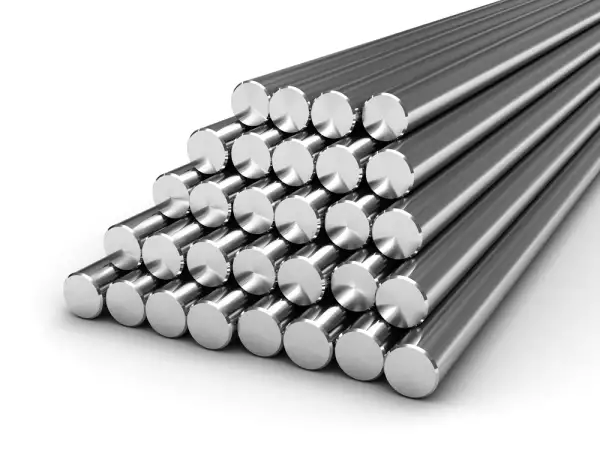This issue is particularly acute when it comes to perform a proper protection of your home antenna. Classical type antenna are usually placed on the roofs of facilities, satellite dishes are often hung on balconies or external walls of the building. Although it is also possible to install them on the roof. This is explained by the fact that grounding of antennas installed in enterprises, is provided at the design stage, and the requirements on this matter are formulated in detail in the industry standard 153-34.21.122-2003 For mobile connection objects - in AD 45.162-2001 (in-house process engineering standards).
Antennas are openly placed, which allows to talk about a very high probability of a lightning strike into them. To minimize negative effects of such an event, special measures of technical protection of antenna structure, such as: integrated holding of potential equalization, installation grounding, are applied. Practice shows that effective protection of all connected devices, which have a high sensitivity, is only possible at the initial connection of devices protecting against overvoltage.
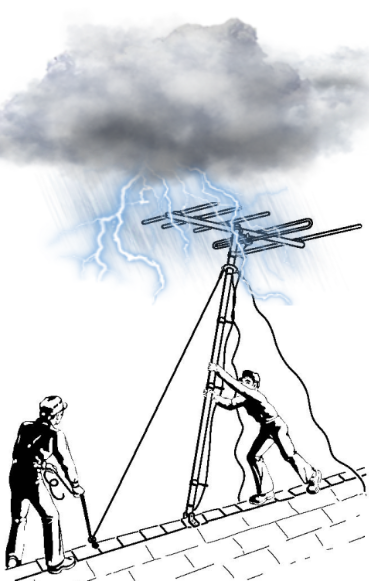
Antennas grounding and lightning protection
Regulations governing lightning protection
Today, the vast majority of works that are carried out by qualified specialists, providing antennas lightning protection, take into account requirements of European regulations introduced by the European Committee for Electrotechnical Standardization CENELEC. First of all, we are going to talk about the provisions of the standard EN 50083-1. This document regulates the basic protection measures against the effects of lightning strike into the antenna. It is important to understand that the provisions of this standard are only applied to permanent devices, or devices mounted in campsites. They do not referto amateur radio stations operating on VSAT platform. In addition to the above, be sure to take into account provisions of two other regulations: GOST R IEC 62305-2-2010 and GOST R IEC 62305-1-2010. The provisions of these documents were introduced by Rosstandart with order 795-ст, dating 30.11.10.
Antennas grounding and potential equalization
External feeders, masts and antennas of any type, located wholly or partly outside the protection zone refer to objects which a lightning can strike. This requirement is due to the exclusion of antenna's current penetration into the room with the help of a special system to prevent the occurrence of a potential difference between its parts, posing danger. The following activities are performed for:
- grounding of TV antennas providing connection of the grounding installation with a metal bar, to which the antenna is fixed. This is done with the help of a special grounding wire;
- potential equalization, which is performed by connecting a grounded mast and all outgoing coaxial cables.
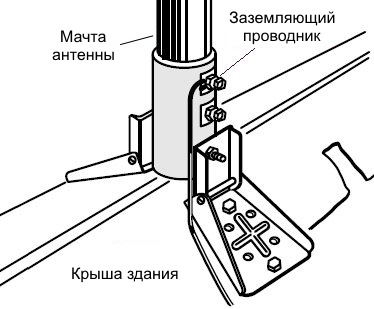
Connection of the ground conductor to the antenna
Мачта антенны - antenna mast
Заземляющий проводник – grounding conductor
Крыша здания – roof of the building
If the antenna mast is located in the vicinity of the building that has lightning protection, it is directly connected to the latter.
If there is no lightning protection in the building, then a grounding device which is further directly connected to the antenna with a special short wire, is mounted.
It is important to remember that a wire laid around certain elements of the structure, can generate a significant potential difference caused by the indactance in wires appearing after a lightning strike. This, in its turn, may cause sparks. Conductive elements (one or more) are used as ground electrodes, with a maximum contact surface with the ground. For example, a ground electode system on the base of modular grounding kit ZANDZ ZZ-000-015.
Each conductor from rod and rope lightning rods must be connected to the ground electrode system, consisting of at least two vertical electrodes at least 3 meters long, united by a horizontal electrode at least 5 m long. It should be deepened to at least 500 mm and should have a minimum cross-section equal to 50 mm2 for copper and 80 mm2 for steel.
Installation recommendations for TA (TV antenna)
The location of your antenna on your site, and its orientation depend on a sufficiently large number of external factors. The mains ones:
- the type of antenna you have selected;
- site location;
- state of territory (relief);
- levels and types of external interference;
- interference caused by power settings, view of AFD, etc.
If the antenna is mounted on the roof, then a mast of a small height metal pipe with a diameter up to 40mm, or a mast of a wooden beam (50 * 50), fixed to the rafters is used as a base. In these cases, the antenna rises above the upper roof point to 2000mm or more.
IT IS FORBIDDEN:
- to mount antenna (its mast) to the ventilation ducts and chimneys, to the electric "jibs" and telephone pillars, as well as dormer windows.
- to mount antenna guys so that they are close to its vibrators or electrical wiring, water supply pipes or sills.
Types of existing lightning protection
Grounding of satellite dishes and antennas of classical types is carried out by one of two basic classical schemes:
- Traditional lightning protection (passive).
With minimal financial investment, relatively simple mounting techniques and subsequent maintenance technology allows to perform antennas reliable protection from lightnings.
The structure of such a protection system includes down conductors. lightning rods. ground electrode systemwhich are united to a single circuit. Rod and mesh cages are most frequently used as lightning rods.
- Internal lightning protection.
This definition includes the full range of works on the protection of electric wiring elements and equipment, located inside the premises, against partial currents and / or pick-up effect which overcame external security and managed to penetrate through the existing communication system. At the same time the possibility of negative impacts occurrence is divided into the following groups: o a lightning strike had a direct impact on electrical equipment (hit to power lines, communication cables, grounding, etc.); o electromagnetic pick-up effects of diverse nature.
According to the currently existing zone concept, three lightning protection zone refer to the studied lightning protection group. On the borders of the zones special devices SPD (Protective equipment), are erected, which are divided into SPDs of 1,2 and 3 classes.
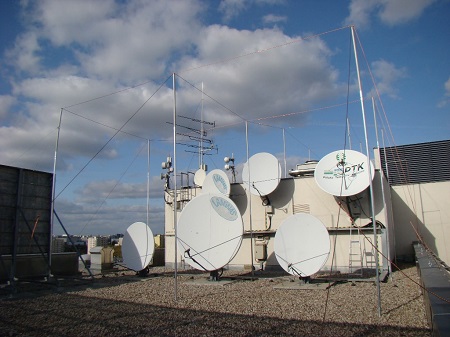
Antennas lightning protection
Lightning protection requirements
If antenna "A" is set outside the zone protected by the lightning rod, you will have to perform a number of activities of protective nature, to perform lightning protection of TV antennas and satellite dishes.
The list of such activities directly depends on the number of external factors:
- design of support for antenna installation;
- type of roof;
- place where the equipment is located.
If "A" is mounted on the roof with a standard grounding (metal), then fixation mast "A" is simply connected to the roof, which provides antennas gorunding in country houses. Many antennas have a loop vibrator as satellite control room.
The main elements of antennas lightning protection systems, common for almost all constructions, are grounding devices and the down conductors. These elements must not have a negative effect on the operation of the antenna. To do this, the down conductor is strictly connected to the point of "zero potential", which may be placed in different areas of antenna's construction.
If the point with the "0" potential is absent, a choke (Д) is introduced into the electrical circuit of the mounted "A"), the choke should be with a great value of inductance, which is connected to the antenna's special terminals. The middle of the down conductor (Д) is the desired point.
On a timber mast a thick metal (preferably copper) wire to drain current is laid. The diameter of the wire may not be less than 5 mm or copper bus of a similar cross-section. The second end of the grounding loop is connected to the ground electrodes. The bus itself or elements of the grounding device, dug into the ground, can peform the roles of ground electrodes.
Antenna on a flammable roof has its own specific features of grounding. For example, the upper part of the metal pipe mast is connected to the point of previously mentioned point "0" - potential "A" and coaxial cables screens. And a down conductor wire is connected to its lower part, which is then laid along the walls of the building, and is grounded by placing it on the bottom of the trench, buried to 1000mm.
See also:
- Webinars with the leading industry experts
- Everything for the calculation of grounding and lightning protection
- Useful materials: articles, recommendations, examples
Related Articles:
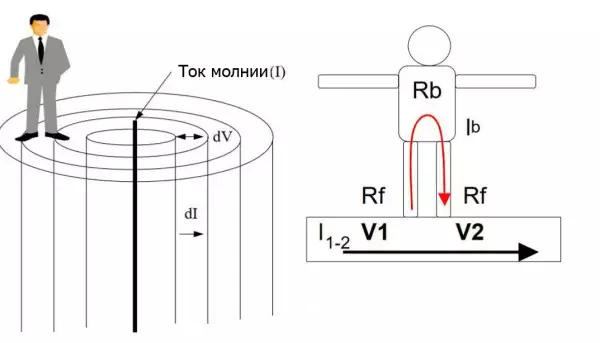 Step Voltage: Dangerous Obscurity and Reliable Protection
Step Voltage: Dangerous Obscurity and Reliable Protection
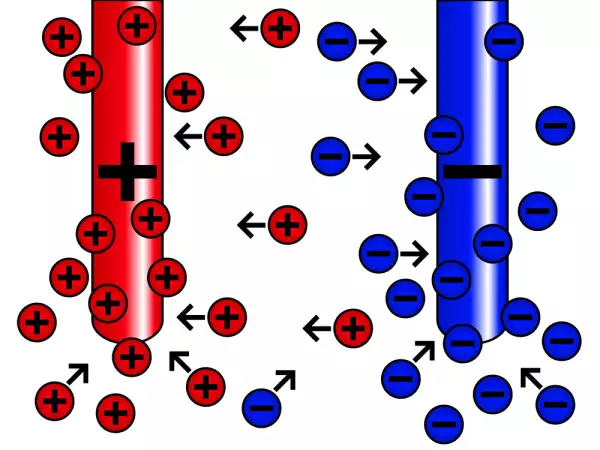 Nature of Electrochemical Corrosion
Nature of Electrochemical Corrosion
 Public Safety in Land Transport in case of Direct Lightning Strike
Public Safety in Land Transport in case of Direct Lightning Strike
